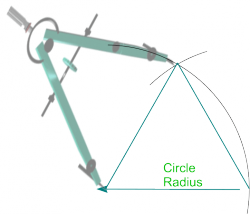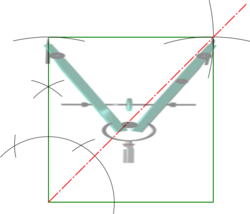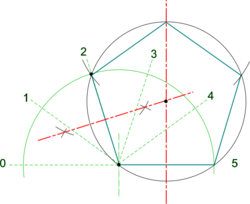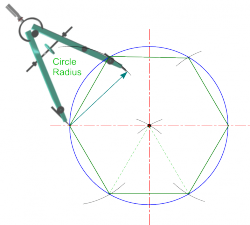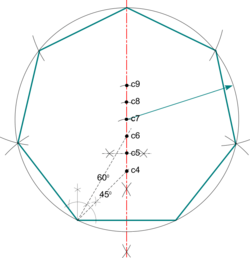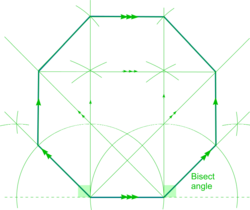Polygons: Difference between revisions
From DT Online
mNo edit summary |
(Completed text and added category links) |
||
| Line 77: | Line 77: | ||
* Bisect the exterior angles at the base to create 45<sup>0</sup> angles as shown. | * Bisect the exterior angles at the base to create 45<sup>0</sup> angles as shown. | ||
* Where these bisectors cut the semi-circles are two sides of the octagon. | * Where these bisectors cut the semi-circles are two sides of the octagon. | ||
* Draw perpendiculars from where the 45<sup>0</sup> lines intersect the semi-circles | * Draw lines from the other end of the line through the top centre of the semi-circle - these will be parallel to the bisectors. | ||
* Draw perpendiculars from where the 45<sup>0</sup> lines intersect the semi-circles up to their intersection with lines through the tops of the semi-circles - these are two vertical sides of the octagon. | |||
* Complete the octagon by scribing lengths of sides from the ends of these vertical sides on to the first perpendiculars drawn as shown. | |||
* Check the accuracy of all points by ensuring diagonals are parallel to sides. | |||
</span> | |||
| [[File:CompassOctagon.png|250px|right]] | | [[File:CompassOctagon.png|250px|right]] | ||
|} | |} | ||
[[Category:Secondary]] | |||
[[Category:Geometry]] | |||
Revision as of 19:36, 25 February 2015
Drawing regular Polygons is now most easily accomplished using modern drafting aids and Computer Aided Design tools. But there are occasions when it is useful to have an understanding of some basic constructions using just rule and compasses (or pegs and pieces of string). Examples might include large scale work for stage sets or carnival floats, or on-site work for buildings, playgrounds, sports fields and gardens.
The following examples are limited to constructions of regular polygons. Irregular polygon construction may be achieved using a process of triangulation, vectors, coordinates or plotting points on a matrix for example. Some other polygons (e.g. Cyclic Quadlitateral) have particular properties which can be helpful to know when constructing them.
See also the YouTube video All the possible polygons!. This shows how all regular polygons can be constructed using classical geometry techniques
Note: Some constructions on the YouTube video may be different to those described below - there are several methods of construction possible for most regular polygons.
| Equilateral Triangle |
|
|
| Square |
|
|
| Pentagon |
Note: Polygons with odd numbered sides have an apex at top centre and this can be used for greater accuracy as an alternatve starting point, or as check, when stepping off sides round the circle .
|
|
| Hexagon |
Note: Polygons with even numbers of sides have diagonals parrallel to the sides and this can be used as a check on accuracy
|
|
| Septagon |
Note: This circle would circumscribe a pentagon and provides an alternative construction.
|
|
| Octagon |
|
